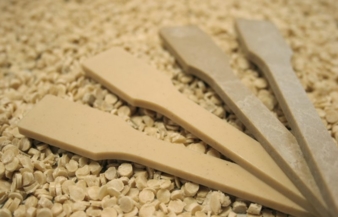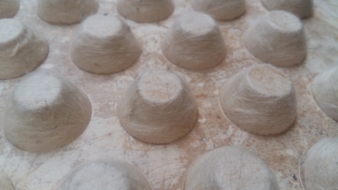25/03/2019 – Cotton products — auf Deutsch lesen
Innovative Cotton-based products
Cotton may be an old fibre but innovation never stops. Especially in a challenging environment like cotton faces, innovation is a key to growth.
Cottons properties make it particularly suitable for new textile creations as well as its use in technical applications. During the 34th International Cotton Conference, industry experts and scientists presented a wide range of innovative textile and technical cotton-based products.
Cotton fibre-reinforced composites for injection moulding and 3D printing
Mr. Milan Kelch, Hochschule Bremen observed that biodegradable materials are needed to substitute for polymers in current use. Natural Fibre reinforced composites can be used in a variety of applications, from construction to automotive parts. Tests indicate that cotton-reinforced PLA has good impact strength and thermal stability, when combined with an impact modifier. Cotton fibre and cotton noil-reinforced compounds for injection moulding offer high and adjustable mechanical properties, that can be compared with ramie and glass fibre reinforced compounds.
Additional research was conducted on whether cotton fibres can be used as reinforcement in 3D printing applications. Early indications are the cotton can indeed be used in 3D printing processes. Cotton-reinforced composites have higher mechanical properties (strength and durability) than materials currently in widespread commercial application.
Thermobonded composites made with cotton and polylactic acid fibres
Ms. Franziska Stehle, M. Sc., Faserinstitut Bremen e. V. reported on processes used in combining reinforcing bio-degradable Polylactic Acid fibers with cotton to produce fiber-reinforced plastic. Polylactic Acid (PLA) is made from starch extracted from plants, particularly maize. PLA can be used to produce fibers that are biodegradable and can be used as matrix fibres. ‘Thermolink’ is an example of the application. PLA melts in the area where it is heated and hardens after cooling. Non-heated areas remain flexible so that the flat surface can be bended. This method can be used for the production of folding smartphone-covers or folding boxes.
Another example are nep cores that are produced using a nonwoven textile of thermoplastic and cotton. The fabric is molded into a three-dimensional structure. The resulting matrix is lightweight and strong relative to its thickness and weight. The panels can be used in building construction and as furniture components. Within the nep cores, strength, acoustic absorption and moisture absorption can be controlled by varying the proportions of cotton and PLA in the reinforced plastic.
Innovative 3D cotton textiles
Dr. Malgorzata Matusiak, Lodz University of Technology, Lodz, Poland and the Gdynia Cotton Association, Gdynia, Poland, outlined that human physiology, clothing characteristics and the environment affect whether clothing feels comfortable to people. Wool has excellent properties of thermal insulation because the crimp and resilience of fibers trap air. Scientists are looking for innovative solutions that emulate the thermal insulating properties of wool with a softer feel.
One innovation is Spinair yarn, also called, “hollow cotton yarn”. It is made by blending cotton with a polymer called Kuralon K-II. During the finishing process, the polymer dissolves, leaving hollow spaces between the cotton fibers remaining in the yarn. The resulting yarns are soft and fluffy and have superior insulating properties compared with conventional cotton yarn.
Innovations are also occurring in fabric construction. Three-dimensional fabric structures can be constructed by joining two facing fabrics with a spacer filament. The structure of the resulting 3D fabrics traps air between the facing fabrics, resulting in excellent insulating characteristics. Dr. Matusiak conducted research on three types of woven seersucker fabric. The thermal conductivity of the seersucker fabrics was compared with plain and twill weave fabrics, in both dry and wet conditions. Tests showed that seersucker fabrics had better thermal insulation properties in all cases.
Excerpt from the Bremen Cotton Report No. 09/10 – March 7th, 2019.
For more information www.baumwollboerse.de/en





